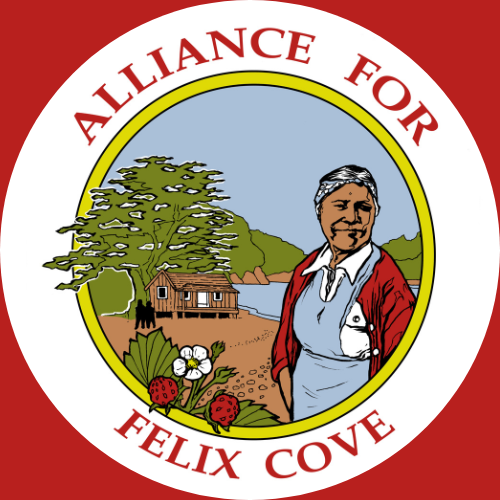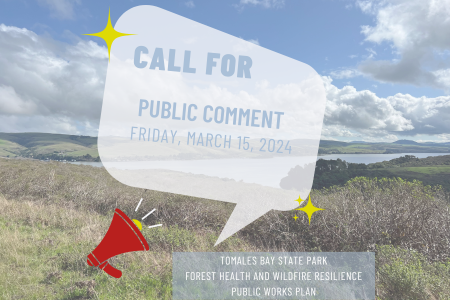
CALL TO ACTION
Oppose utilizing fossil fueled Western treatment methodologies for restoration
A statement from Theresa Harlan, Founder + Director, The Alliance for Felix Cove in opposition of: Tomales Bay State Park Forest Health and Wildfire Resilience Public Works Plan
My name is Theresa Harlan. I am the director of the Alliance for Felix Cove. We are an all Indigenous women led organization working to rematriate my mother’s Támal-ko/Coast Miwok Felix Family home on the west shores of Tomales Bay at Point Reyes National Seashore. Our family lived at the cove mapped as Lairds Landing until the mid-1950s and was part of the community of Támal-ko families living in coves with fresh water streams including coves at Tomales Bay State Park. These written comments supplement my oral testimony on January 10, 2024 at the public hearing at Marconi Lodge.
I oppose the use of the PWP proposed activities (e.g., prescribed burning, mechanical treatment, herbicide application) because they are harmful to the plant and animal life at the Park.
I recommend Park staff leverage your California Natural Resources Agency’s work towards co-stewardship of public lands by bringing Indigenous ecologists to the table to add Indigenous-based solutions to the PWP. This could be the Park’s opportunity to exemplify co-stewardship practices and give real meaning to Agency’s movements to engage with California Indigenous peoples and traditional ecological knowledge practices. Agency appears to move towards removing historical and institutional practices of invalidating California Indigenous peoples, the knowledge they carry and their direct and continued relationship to ancestral homelands. This PWP does not acknowledge this work in a meaningful way.
I call your attention to missing elements in the PWP. As written the PWP does not include pros/cons, risk analysis, or cost analysis for any of the proposed activities and tools. It’s unclear if and when the administrative requirements and procedures direct the Park to share this information or if this information will be provided at another stage of the process. As members of the public we need to know what the potential harmful effects from the proposed activities and tools will be. This impedes the public’s ability to evaluate the impact if this plan is implemented. We are only provided with the benefits, making the PWP read more like a marketing brochure.
This ten year plan names state and local agency consultations, including tribal consultation with the Federated Indians of Graton Rancheria. At the public hearing Park staff acknowledged the impact of the years of neglect since Coast Miwok stewardship ended. Bree Hardcastle stated, “Since colonization humans have dramatically altered the landscape of the Park and Tomales Bay. We’ve had profound impact on the vegetation resulting in habitat degradation.”
Why employ aggressive Western-based methodologies in the name of restoration? Why does the PWP ignore Indigenous ecology practices also known as traditional ecological knowledge as part of the solution for restoration? Parks can go further by putting into practice all of the good work currently underway with Agency’s 30x30, Tribal Affairs Department, Tribal Nature-Based Solutions Program and the upcoming Indigenous Co-Stewardship of Public Lands, i.e., integrate and apply California Indigenous ecological knowledge and solutions. This would add tribal nature-based solutions to the PWP that respects and treats all living beings as our animal and plant relatives and as practiced by Támal-ko ancestors. The Park bears the responsibility to make the best decisions using state funds. The PWP should go further to demonstrate an awareness and incorporation of Indigenous ecological solutions in the PWP instead of only offering the identified activities and tools (e.g., prescribed burning, mechanical treatment, herbicide application).
Támal-ko ancestors would not employ destructive actions as it makes no sense to harm the very ecosystem that sustained and gave them life. They would not harm their Mother. Their descendants who are Indigenous ecologists would apply practices in alignment with ancestral teachings and recognition of the interconnectedness of all life beings. Why would the Park propose utilizing Western treatment methodologies such as fossil fueled heavy equipment to masticate trees and shrubs or herbicides for restoration?
The California Land Stewardship Network advocates “We understand our approach to conservation must evolve to be more inclusive and to support the leadership of under-resourced people and communities of color, who have long stewarded the land or been denied access to it. We can no longer work in isolation. We must leverage the tremendous power of partnerships to ensure that stewardship action drives the changes that both people and nature need.”
Here are a few resources familiar to me. There are many more within the state. The Cultural Conservancy is known as promoting Indigenous ecological practices. The Cultural Conservancy has an Indigenous food garden, Heron Shadow Farm. They are also known for teaching cultural burns with Redbird Willie, Indigenous ethnobotanists. Their board chair is Melissa Nelson, professor of Indigenous Sustainability at Arizona State College (Marin resident). Cultural burn experts include Don Hankins, professor of geography and planning at CSU Chico. There are more Indigenous ecologists this is just a few whom the Park could start conversations with to integrate Indigenous stewardship practices.
As Indigenous people we come to state and federal public lands not as tourists or outdoor enthusiasts, but as relatives returning home.
Respectfully,
Theresa Harlan, Director
Public Works Plan No. PWP-2-MAR-24-0001-1 (Tomales Bay State Park Forest Health and Wildfire Resilience Public Works Plan)
The hearing originally scheduled on Friday, March 15, 2024 has been *postponed* but you can still submit your comments via email (see link in agenda). The Commission will hold a series of hearings this day starting at 9am and will move through each agenda item in order. This matter is on the agenda as item number 10a on Friday, March 15, 2024.
How to provide testimony at this hearing. Please see the Coastal Commission’s Virtual Hearing Procedures posted on the Coastal Commission’s webpage at www.coastal.ca.gov for details on the procedures of this hearing. If you would like to receive a paper copy of the Coastal Commission’s Virtual Hearing Procedures, please call 415-904-5202.
In support of our relatives, the Tule Elk
A statement from Theresa Harlan, Founder + Director, The Alliance for Felix Cove in support of Alternative B: Unconfined Elk Herd and Pierce Ranch Core Area
Ka molis (Thank you) Point Reyes National Seashore for proposing to remove the elk fence from Point Reyes. I am writing to support your recommendation of Alternative B: Unconfined Elk Herd and Pierce Ranch Core Area. The tule elk are not solely “ungulates” for the Támal-ko/Coast Miwok ancestors, they are our relatives, contributing to a cycle of life between human, animal and plant relatives.
I urge you to make an exception to your recommendation and not “Discontinue provision of supplemental water and minerals for tule elk. Remove all existing, non-historic supplementary water systems.” We are still in climate change with drought and rising temperatures. The tule elk may still need supplemental nutrients and water. The removal of the fence will not change the existing vegetation or water sources. While I understand the tule elk will be free to move to other areas, their movement may likely not be predictable to ensure full nutrition and water sources.
I am concerned about population management that would rely on culling, i.e., shooting healthy tule elk. I hope the Park will look north to efforts regarding Roosevelt Elk management. For example, the Karuk Tribe has worked extensively on Roosevelt Elk management with UC Berkeley and state and federal agencies. This work addresses social and environmental injustice and goes further to "restoring local ecosystems and watersheds, expanding access to cultural foods and fibers, supporting local subsistence economies and community health, revitalizing cultural and ceremonial practices and enhancing self-governance and tribal sovereignty.”
In Alternative B, the National Park states “Continue to partner with the Tribe for the preservation and protection of significant cultural resources.” I urge you to expand the Park’s understanding and scope of “cultural resources” to recognize and address the history of the coves that Támal-ko/Coast Miwok people called home, places such as Pelican Point and White Gulch. These areas were home to Támal-ko/Coast Miwok families. Additionally, Pierce Point was a site for abalone harvest by Támal-ko/Coast Miwok families. The ocean side of Pierce Point was a site for collecting lumber, fallen from ships, used for building homes and barns by Támal-ko/Coast Miwok families. I urge the Park to work with the Alliance for Felix Cove and Federated Indians of Graton Rancheria to tell these stories and histories. Visitors, locals, and Indigenous communities are eager to learn of these untold histories.
With Alternative B, the National Park has the opportunity to teach and celebrate how life is interconnected to all things. For thousands of years the life cycles of tule elk and human moved in synchronicity. A time to burn, to ensure tule elk grazed on nourishing grasses. A time to prepare and teach young hunters. Human, animal, plant and waters—contributed to the ecology of life.
The National Park, if Alternative B is implemented, could realize what the Park was meant to be and do, ensure “the maximum protection, restoration, and preservation of the natural environment” and “provide for the enjoyment of the scenery, natural and historic objects, and wildlife in such manner and by such means as will leave them unimpaired for the enjoyment of future generations.”
The enjoyment for future generations is paramount for visitors, local residents, and Indigenous communities. Commercial dairy and beef cattle operations are incongruous to a National Park. Visitors, local residents and Indigenous communities shouldn’t be denied to experience Tomales Point in its full beauty of vibrant and resilient ecosystems which can foster a harmonious coexistence between humans and our remarkable animal and plant families.
- Theresa Harlan, Founder + Director
Yes for Alternative B: Unconfined Elk Herd and Pierce Ranch Core Area
CALL TO ACTION 📣
Public comment is open for the Tomales Point Area Plan (TPAP) that could end the suffering and high mortality of our sacred relative, the Tule Elk at the Elk Preserve. It’s time to renew our relationship with the Tule Elk by providing a healthy environment of native grasses and clean waters so our relatives can be healthy and strong. It’s time to bring in Indigenous scientists and tear the fence down.
The National Park Service (NPS) is accepting public comment regarding the plan for the Tomales Point area of Point Reyes National Seashore (Seashore) now until Monday, 9/25. Share your support for Alternative B: Unconfined Elk Herd. The Tule Elk depend on you.
References
Sowerwine, J., Sarna-Wojcicki, D., Mucioki, M., Hillman, L., Lake, F. K, & Friedman, E. (2019). Enhancing Indigenous food sovereignty: A five-year collaborative tribal-university research and extension project in California and Oregon. Journal of Agriculture, Food Systems, and Community Development. Advance online publication. https://doi.org/10.5304/jafscd.2019.09B.013
The 2018 California Department of Fish and Wildlife Elk Conservation and Management Plan. https://nrm.dfg.ca.gov/FileHandler.ashx?DocumentID=162912&inline is noteworthy regarding confined tule elk herds.
2018 Plan
Goal 1. Reduce the number of confined herds and the frequency for removing excess animals. Objective 1.1. Eliminate one or more confined herds by 2025. With the implementation of Alternative B the State’s 2018 Goal 2 would not come into play. It’s worthy to note.
Goal 2. Enhance habitat within enclosures. Elk within confined herds rely on a limited area of use to acquire yearlong nutrition. Habitat conditions within enclosures should be enhanced to provide a healthy environment for elk.
Objective 2.1. Enhance elk habitats by at least 5% by 2028.
Action 2.1.1 Map current elk habitat to detect change over time and guide management decisions. Expected completion: 2021.
Action 2.1.2 Meet annually with CDPR, USFWS, and NPS to identify opportunities to enhance elk habitats. Ongoing.
Action 2.1.3 Work with NPS to identify/establish specific vegetation management thresholds for Tomales Point. Expected completion: 2021.




